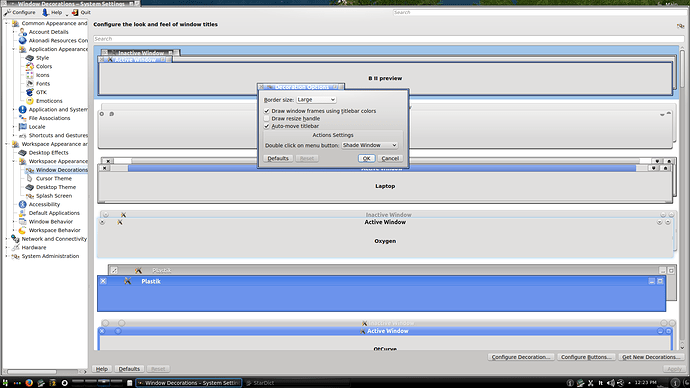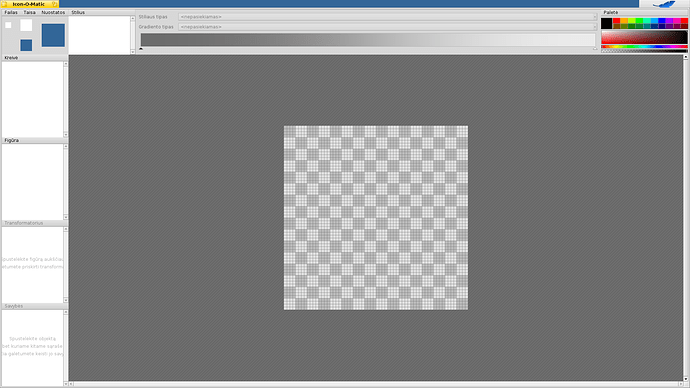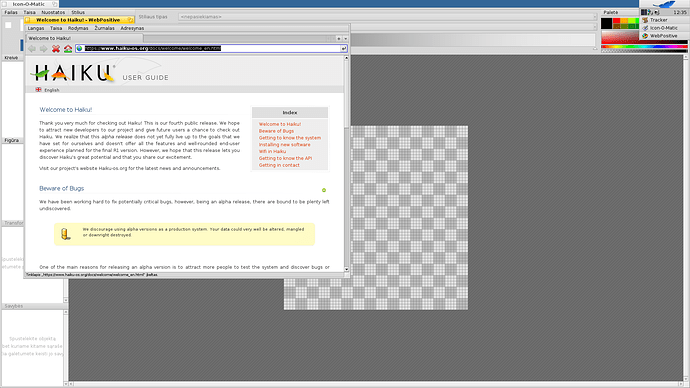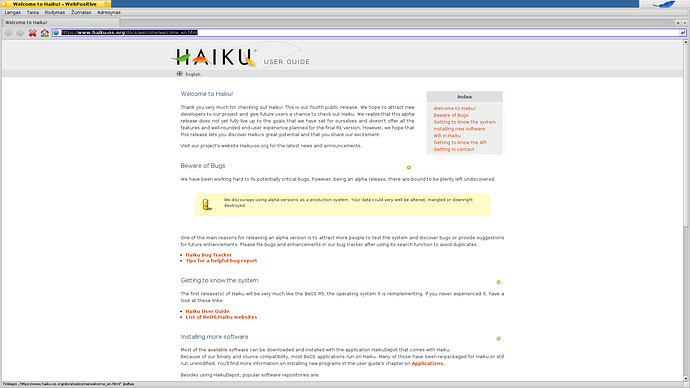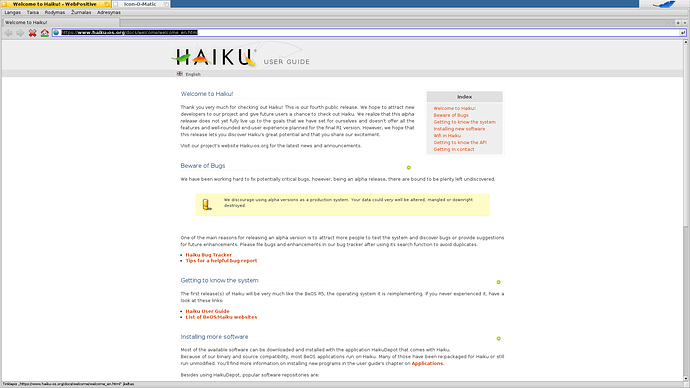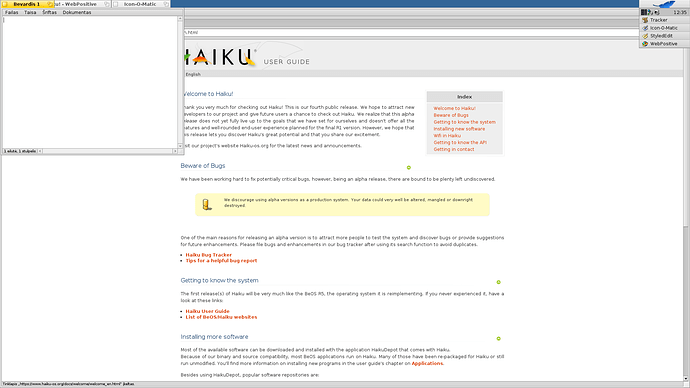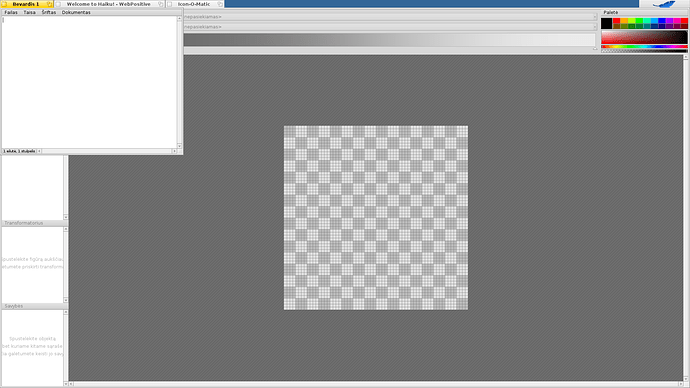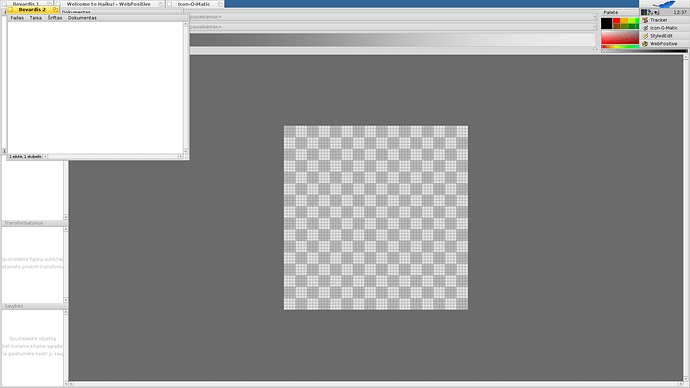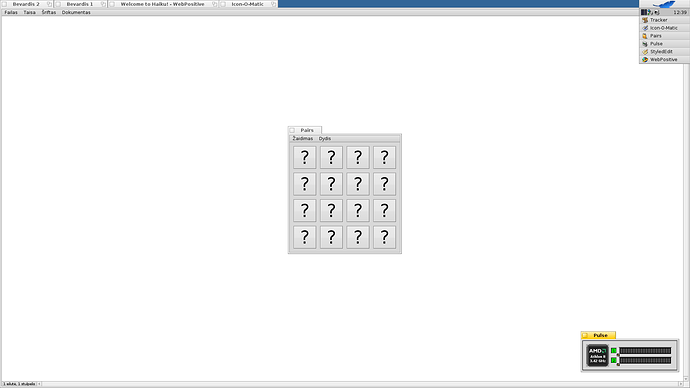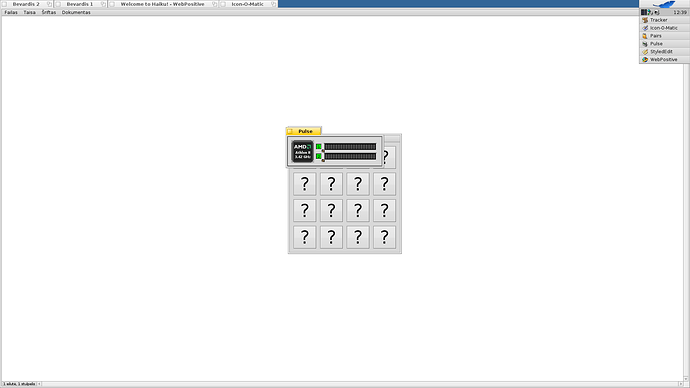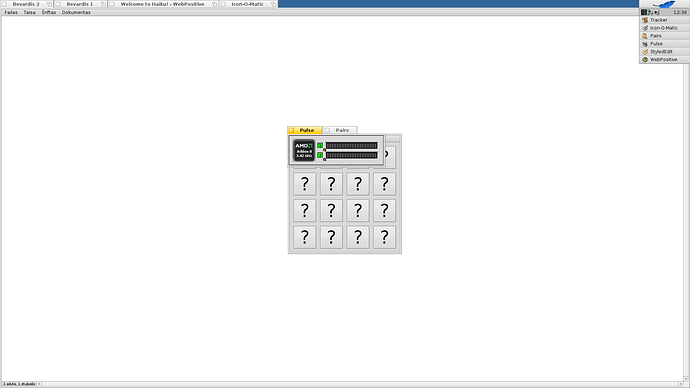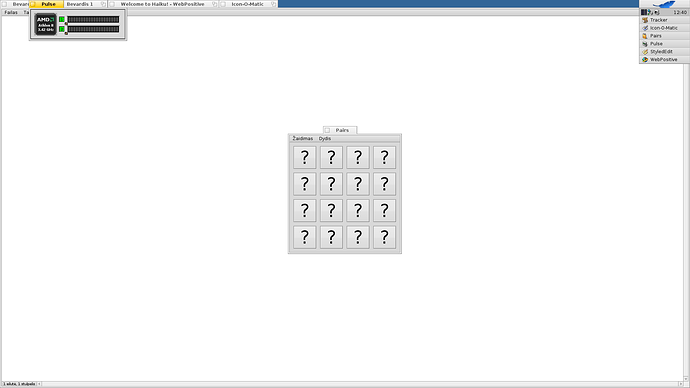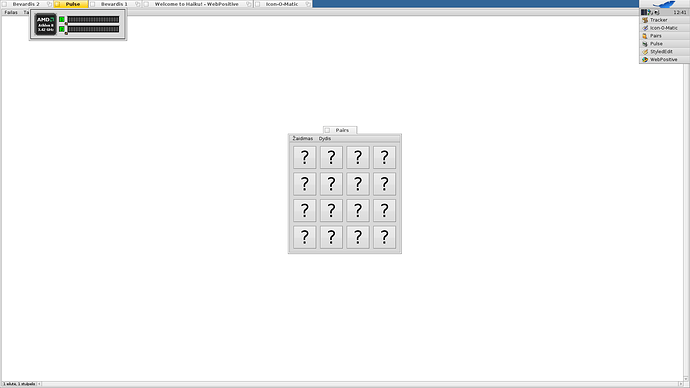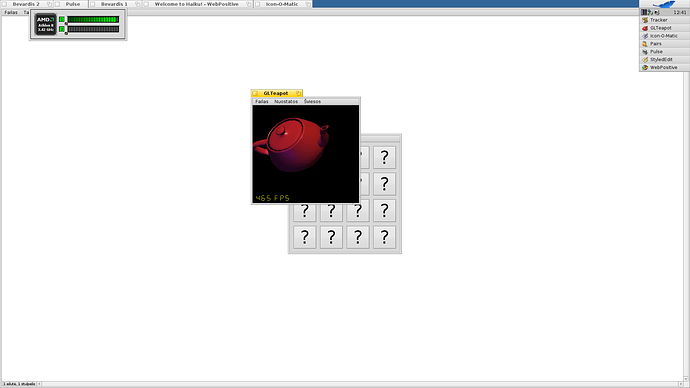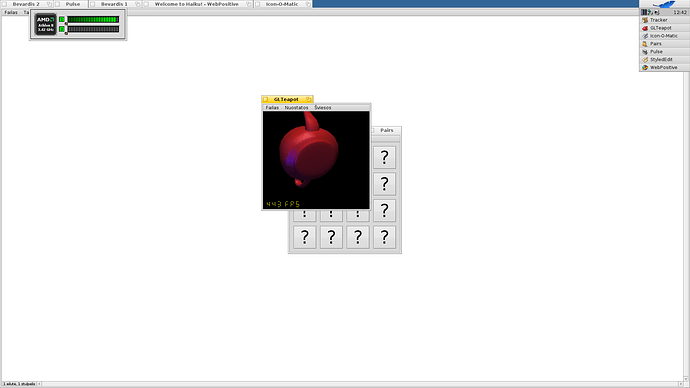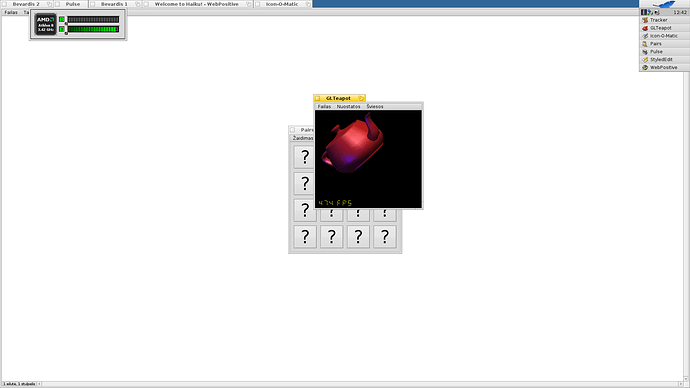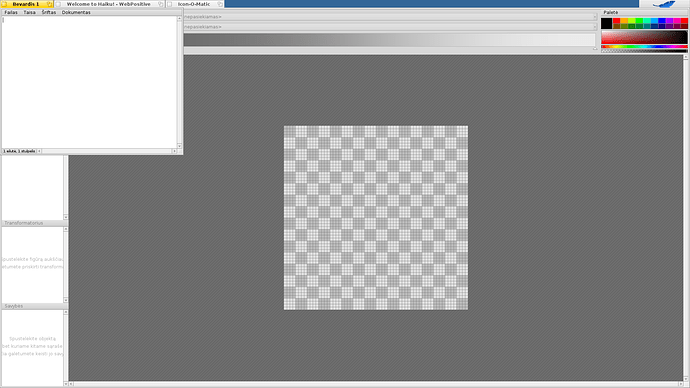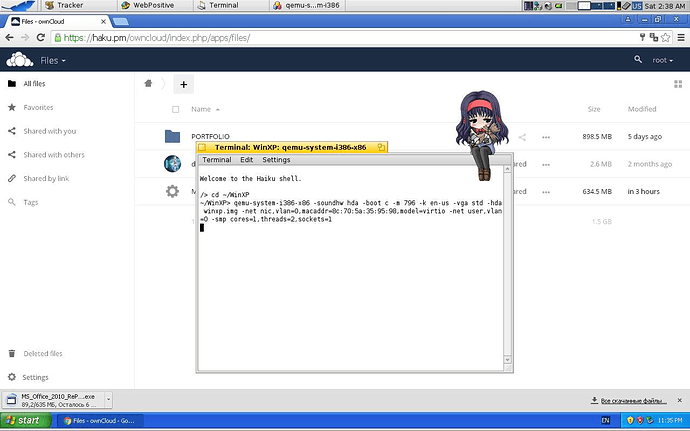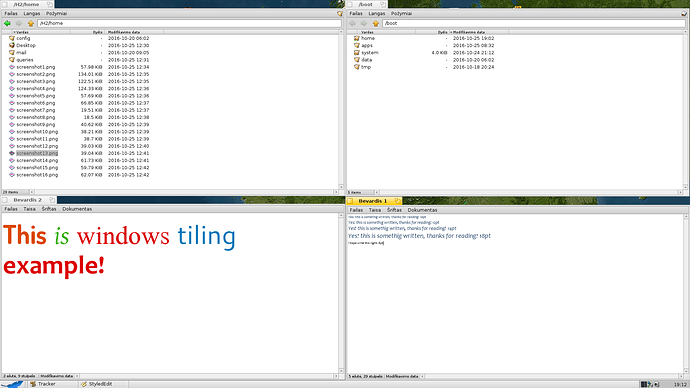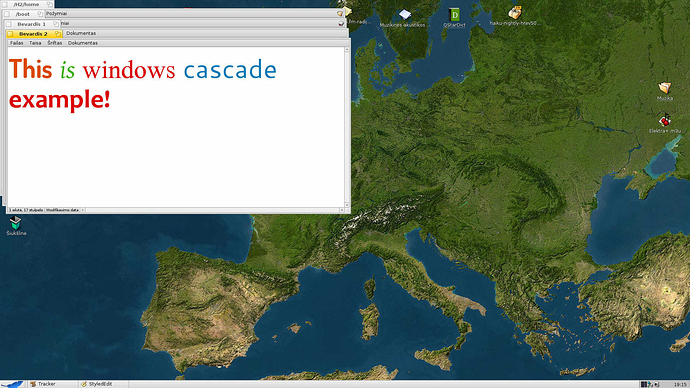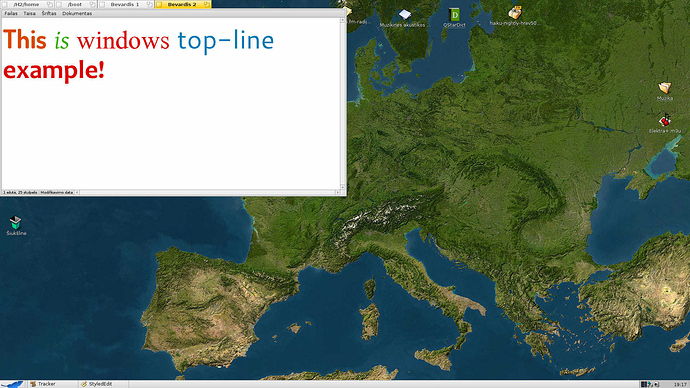Autoslashing (auto moving) tabs, like in KDE B2.
Scaling GUI elements according to monitors DPI.
GUI theme like Gotchione in GTK2 or Oxygen in KDE.
Mouse pointer, windows and menus must drop shadow.
Icons BeOS like theme, like in Zeta OS (Maclintock?).
New Firefox or Chromium in Haiku.
Wine.
Good list, but I didn’t get the first 2 references mentioned.
I humbly admit I haven’t heard of KDE B2 (beta 2 or build 2 of Plasma?) or is B2 more like a concept, like the Gnome OS or 2.9 was? Confused here and tried searching the web for it. Maybe others might be befuddled here too. 
Also, didn’t fully get and couldn’t find “autoslashing tabs” anywhere. Tried the wiki (user base and tech base: https://techbase.kde.org/index.php?search=autoslashing&title=Special%3ASearch) but nothing popped up. To try at an educated guess… is this where the UI suggests paths to autocomplete as you type like the Go to Folder box in Finder or the Windows Run box in 98? Or the ability to scale/cut tab sizes intuitively? Vista-style breadcrumbs? Or all the above? I admit I do use gnu/Linux, etc. along with Haiku, but don’t really use KDE (or Gnome Shell for that matter) so I’m a tad lost here; so forgive me for being ignorant on KDE. I quit following it around 4.4 or so.
But anyway, for all the ideas I did understand, I’d agree with you totally! 
(Well, except I think Haiku is as close to the old Be set that it could legally/safely get. But yeah, I think an alternate icon set or chooser would be a great addition!)
In KDE is optional BeOS like window frame called “B2”: in it tabs from different windows can auto move aside when overlap each other.
Sorry, I am not english man…
Haiku work with monitors like all they are the same 72 dpi, and on bigger dpi monitors all GUI elements are to small. Of course, increasing size of the font slightly rescues.
Thanks for clarifying this for me. I understand it all now; it’s my mistake as I wasn’t thinking of themes. So, B2 is kind of similar to the B5 or B6 window themes on Xfce then (except those tabs are static/stagnant on Xfce instead of doing any tab magic). Also, your English is actually fairly good. 
And to add a few ideas for Haiku to this thread…
A Haiku enhancement I’d welcome is to be able to either have an option toggle or hold Option down in Haiku’s Leaf menu for additional options (like Mac OS has in the Apple menu). For those who haven’t used Mac OS 10.2+, Windows 8.1 (9) and 10 sort of have this as well with the command menu when one right-clicks the Start button or presses Win+X. I’d try this, but key bindings in cpp are a dull area of mine.
More Deskbar enhancements that would be awesome would be a Force Quit option like Mac OS 10.x, or just “Team Monitor” to bring it up from the Leaf menu, and the ability to clear recent item history.
And the others, like UI element scaling for hiDPI displays, are close to the same suggestions as damoklas mentioned.
B2 is less powerful than our Stack And Tile (try moving a window while holding the window key and dropping it over the tab bar of another window)
“Force quit” in Haiku is done with a key combo known as the “Vulcan Death Grip”: ctrl+alt+shift+click on the app entry in the deskbar. You can also kill apps from the ProcessController (the CPU load meter in DeskBar).
I don’t understand what you mean with this “advanced” leaf menu, and no, I don’t use either Mac OS X or Window 8 and later.
GUI themes: we have all the internal support, themes (or “engines” as they are called in GTK) can be written as C++ code. If someone does a new theme, we will add support for switching in Appearance prefs.
Drop shadows: if this ever happens, please make it optional, I don’t want them 
Firefox/Chromium: the Haiku team is busy with the OS and would appreciate it if other people worked on porting apps 
Wine: not an easy task, mainly because of differences in the way we set up the memory space. The wine wiki has a page summarizing the biggest problems.
I do not agree about less power of B2 mentioned feature, it is just another type of useful feature:
when you open another window (or placed on the older), new tab do not overlap tab of older window, new tab (or older window tab) just automatically steps aside (windows do not stacking, only tiling). With this feature you see all names of opened windows, you do not need to look for it „where it hiding?“
How about Haiku GUI and monitors dpi?
Hi,
Could you point us to some screenshot showing how this “not overlap tab stashing” looks and behave? Is is some auto-tiling-all-windows feature?
E-mail that I can set up as easily as with other oses, especially when setting up a gmail account. Every time I try to set up various accounts, whether gmail or others, something goes wrong and either I can’t send, can’t receive, or both.
If I understand and remember correctly, in KDE with the B2 theme, when you maximize multiple windows, their tabs (just the tabs) will be shifted automatically, so they are not all at the same position on the left. It creates something similar to Stack&Tile stacking, but without actually stacking the windows.
In Haiku you can do the same manually, by stacking the windows, or just sliding their tabs (I forgot the exact keyboard shortcut for that).
Please report your mail account setup problems (with details of what needs to be fixed manually) in New or corrected email provider info anyone? 
We can then update our provider database and try to provide a better default setup.
Yes, something like auto-tiling-all-windows feature. Goal of the feature: Window Tab must seek to be maximum visible to the user.
Screenshots explanation
This is how it works in KDE (not quite good, actualy):
First app window:
Second app window:
On Haiku:
First app window:
Second app window:
– it is ok, but if I make window to full screen:
– second window tab overlap tab from first window!
And with “auto-tiling” must happen this:
If I run third app, happen this:
But with “auto-tiling” (thanks for the term!) must happen this:
Further, happens this:
– it is ok, but when app goes to full screen:
and it is not ok, and with “auto-tiling” automatically mus be:
(Sorry, tab of left corner app must be yellow)
Another situation:
– it is ok, but when I put window tab over other tab happens this:
see? one tab one tab disappear, not good, and with “auto-tiling” must happen this:
Further, if I move window to top,
without “auto-tiling” happens:
but with “auto-tiling” must be (sorry, Pulse tab moved on it’s window, that is not right):
– tabs from inactive windows must step aside and make place for active window tab.
Third situation:
but with “auto-tilling” must happen this:
– tab of inactive window seek visibility for user!
but if I move active window back, with “auto-tiling” must happen this:
It looks like you are trying to stack the windows. With Haiku you need to hold the ‘alt’ or ‘opt’ keys in order to enable the stack and tile features.
Holding the ‘alt’ key and moving two tabs close to one another looks like this:
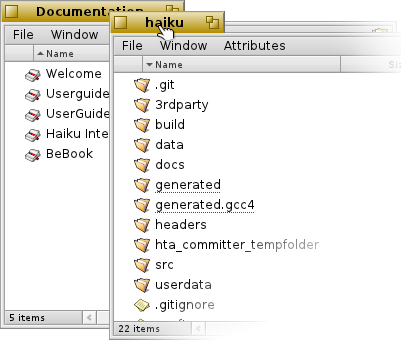
Once they have joined together they look like the right two windows in this image:
Note how when they are properly joint together, they both share a “zoom” or maximise button!
No, I am not trying to stack the windows, just want to see more tabs.
Only tiling windows, no stacking windows.
And no ‘alt’ or ‘opt’ keys.
No joining windows.
It is different feature.
Just automatic ‘Auto-tiling’ or like in KDE called ‘Auto-move titlebar’ feature.
Actually, I wanted this feature from BeOS days.
But that is what tiling is!
This auto-tiling only for auto-moving aside windows tabs (titlebar), for maximum visability of opened applications windows titles.
Actually this tilling of yours is what Haiku also needs:
some keyboard keys to tile or cascade windows on the screen. Maybe are some?
Ok, another useful feature for working with windows in Haiku:
keyboard keys to:
- ‘tile’ opened windows on the screen;
- ‘cascade’ opened windows on the screen;
- and only Haiku feature, ‘top line’ opened windows on the screen, like this:
The only additional feature I would want to have is the ability to control the behavior of windows based on their handles from the shell (there is something like that in i3wm). This way it would be easy to write startup scripts that can automatically position and align different windows based on the user’s preferences. This could also allow the functionality @damoklas is talking about, but I personally see no need in such. Right now I feel totally comfortable with the Deskbar, as it allows to quickly find the needed window without the windows being automatically tiled here and there.
Yes, it is not a problem when opened just several windows, but if you opened much more, or you want to quickly see what is in them at the same time, or just organize better your enviroment (for better thinking and creativity process, or just for saving time  ) you need this features:
) you need this features:
Quick keys to tile opened windows:
Quick keys to cascade opened windows:
Quick keys to top-line opened windows:
And of couse, you need auto-move-tile titlebars (windows tabs) feature.
